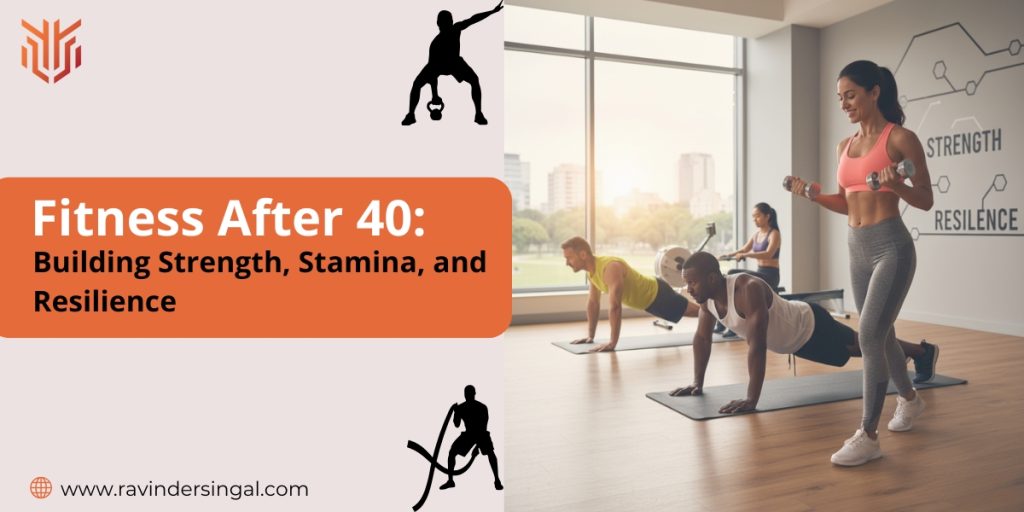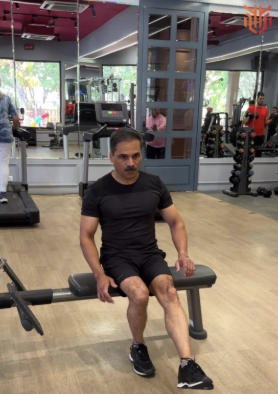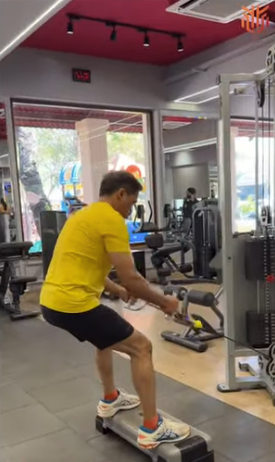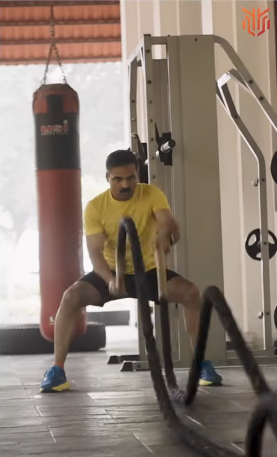Fitness After 40: Building Strength, Stamina, and Resilience

Entering your 40s doesn’t mean slowing down – it’s an opportunity to re-set, refine, and rebuild your body with greater wisdom. Fitness After 40 is about combining experience with evidence-based practices so you can stay strong, energetic, and resilient over the decades ahead. In this post, I walk you through how to stay fit after 40, with strategies for strength, stamina, recovery, nutrition, and sustainable habit formation.
Why Focus on Fitness After 40?
Turning 40 often brings physiological changes: slower metabolism, gradual loss of muscle mass (sarcopenia), shifts in hormonal balance, longer recovery times, and perhaps one or more chronic conditions (blood pressure, glucose, joint wear). Without the right approach, many find themselves less energetic, more prone to injury, and frustrated.
But with strength training after 40, smart cardio, attention to recovery, and disciplined nutrition, you can not only maintain but also improve your physical health. In fact, your 40s can become your decade of peak functional fitness.
A recent Lancet-based study shows that in India, nearly half of adults fail to meet minimum physical activity recommendations – a warning especially relevant for people over 40. Sedentary behavior tends to increase with age.
By embracing fitness now, you dramatically reduce risks of metabolic disease, cardiovascular disease, osteoporosis, joint degeneration, mental health issues, and loss of independence.
In short: Fitness After 40 is not optional – it’s essential for longevity, quality of life, and resilience.

चालीस के बाद सावधान – अब शुरू होती है असली फिटनेस की कहानी
चालीस की उम्र के बाद शरीर और स्वास्थ्य में बदलाव स्वाभाविक रूप से महसूस होने लगते हैं। मेटाबॉलिज्म धीमा होने लगता है, हड्डियों और मांसपेशियों की ताकत घटती है, और दिल व जोड़ों पर अतिरिक्त दबाव पड़ता है। इसलिए, इस उम्र के बाद फिटनेस सिर्फ शौक नहीं, बल्कि ज़रूरी जीवनशैली का हिस्सा बन जाती है।
उम्र के साथ आने वाले शारीरिक बदलाव
- मेटाबॉलिज्म में कमी: कैलोरी बर्न करने की क्षमता घटने लगती है, जिससे वजन बढ़ने का खतरा रहता है।
- हड्डियों और जोड़ की कमजोरी: ऑस्टियोपोरोसिस और जोड़ दर्द जैसी समस्याएं आम हो जाती हैं।
- दिल और रक्तचाप संबंधी जोखिम: उच्च रक्तचाप, कोलेस्ट्रॉल और हृदय संबंधी समस्याओं की संभावना बढ़ जाती है।
चालीस के बाद फिटनेस का मतलब केवल जिम में घंटों बिताना नहीं है। यह एक संतुलित जीवनशैली अपनाने का समय है:
- संतुलित आहार: प्रोटीन, फाइबर, विटामिन और मिनरल्स से भरपूर भोजन अपनाएं।
- नियमित व्यायाम: कार्डियो, स्ट्रेंथ ट्रेनिंग और योग का संयोजन शरीर की ताकत और सहनशीलता बढ़ाता है।
- मानसिक स्वास्थ्य: मेडिटेशन और माइंडफुलनेस से तनाव कम होता है और नींद में सुधार आता है।
चालीस के बाद फिटनेस केवल शारीरिक ताकत नहीं, बल्कि जीवन की गुणवत्ता बढ़ाने का साधन है। यह समय है अपने स्वास्थ्य पर ध्यान देने का, ताकि आगे के सालों में सक्रिय, ऊर्जा से भरपूर और रोग-रहित जीवन जिया जा सके।
टिप: रोजाना कम से कम 30 मिनट हल्की-फुल्की एक्सरसाइज, संतुलित आहार और पर्याप्त नींद आपकी फिटनेस की नई कहानी की शुरुआत है।
Core Pillars for Fitness After 40
To succeed at fitness in your 40s and beyond, focus on these core pillars:
- Strength training after 40 (to preserve muscle and bone)
- Building stamina after 40 (cardio, endurance)
- Recovery and flexibility after 40 (mobility, rest)
- Nutrition for fitness after 40
- Consistency, mindset & motivation
Each pillar interacts with the others – none works alone.

Strength Training After 40: Why & How
Importance of Strength Training
- Muscle mass naturally declines ~1% per year after age 30 if not challenged.
- Bone density benefits: Loading stimulates bone formation, reducing osteoporosis risk.
- Improved insulin sensitivity, metabolic rate, posture, and functional capacity (lifting, climbing, daily tasks).
- Injury prevention: stronger stabilizers, better joint support.
How to Design a Strength Routine
- Aim for 2 – 3 sessions per week (nonconsecutive days).
- Use compound movements: squats, deadlifts, lunges, push-ups, rows, pull-ups, and presses.
- Combine bodyweight, free weights, resistance bands, and machines.
- Gradually increase load (progressive overload).
- Prioritize form over weight, especially as joints become more vulnerable.
- Include unilateral work to catch imbalances.
Example Strength Training Routine for 40-Year-Olds
| Day | Focus | Sample Exercises |
| Day 1 | Leg + Core | Goblet squat, Romanian deadlift, side plank, bird dog |
| Day 2 | Push + Pull | Push-ups, dumbbell row, overhead press, lat pulldown |
| Day 3 | Full-body / lower volume | Step-ups, kettlebell swings, pull-up assist, farmer’s walk, stretching |
Rest days or light active recovery (walking, yoga) are crucial.
Building Stamina After 40 (Cardio & Endurance)
Strength is essential, but stamina ensures you can breathe easier, move longer, and recover faster.
- Steady-state moderate cardio: brisk walking, jogging, cycling, swimming – 30 – 60 minutes, 3 – 4 times/week.
- Interval training: shorter bursts of high intensity (30s all-out, 1 – 2 min rest).
- Low-impact options: elliptical, rowing, pool work – kinder to joints.
Sample Cardio Program
- 3 days moderate steady-state (30 – 45 min)
- 1 day interval or tempo work
- 1 optional “fun” cardio (dance, hiking, sports)
- Active recovery (walking, mobility) on off days
Recovery & Flexibility After 40
Recovery slows with age, so attention to rest, mobility, and sleep is critical.
Strategies for Better Recovery
- Prioritize 7 – 9 hours of sleep.
- Use active recovery: walking, stretching, and foam rolling.
- Mobility sessions (yoga, dynamic stretching) 2 – 3 times/week.
- Include deload weeks every 6 – 8 weeks.
- Nutrition & hydration support recovery.

Nutrition for Fitness After 40
Macronutrient Focus
- Protein: 1.2 – 1.6 g/kg body weight for muscle repair
- Complex carbs: whole grains, legumes, vegetables
- Healthy fats: omega-3s, monounsaturated fats
Micronutrients & Considerations
- Vitamin D, Calcium, Magnesium, Zinc for bones & muscles
- Antioxidants (C, E, polyphenols)
- Hydration: regular fluid intake
Sample Daily Meal Outline
- Breakfast: oats + protein + fruit + nuts
- Mid-morning snack: nuts + fruit
- Lunch: lean protein, whole grains, vegetables
- Afternoon snack: yogurt + berries or hummus + vegetables
- Post-workout: protein + banana
- Dinner: lean protein + vegetables + healthy fats
Designing a Workout Routine for 40-Year-Olds
Weekly Blueprint
| Day | Focus | Duration / Notes |
| Monday | Strength (lower body + core) | 45 – 60 min |
| Tuesday | Cardio + mobility | 30 – 45 min |
| Wednesday | Strength (upper body) | 45 – 60 min |
| Thursday | Active recovery/mobility | walking, yoga, foam rolling |
| Friday | Strength (mixed) | 45 min |
| Saturday | Cardio | 30 – 45 min |
| Sunday | Rest or light activity | walk, play, rest |
Staying Active After 40: Lifestyle Integration
- Take walking breaks every hour
- Use stairs over elevators
- Short movement micro-breaks (bodyweight squats, push-ups)
- Weekend hikes, cycling, and swimming
- Wearable trackers for accountability
- Make fitness social
Fitness Motivation After 40: Mindset & Sustainability
- Set SMART goals
- Track progress & celebrate non-scale wins
- Use accountability partners
- Vary your program
- Allow deloads and rest
FAQs on Fitness After 40
1. Can I really build muscle in my 40s?
A: Yes, with proper strength training, nutrition, and recovery, muscle gain is achievable.
2. How often should I work out?
A: 4–6 sessions/week combining strength, cardio, mobility, and rest.
3. Is it too late if I’ve never exercised before?
A: Start gently, progress gradually.
4. Should I take supplements?
A: Supplements can support, but prioritize whole-food nutrition first.
5. How do I avoid injuries?
A: Warm-up, proper technique, progressive load, mobility work, rest.
6. How do I stay motivated long-term?
A: Set goals, track progress, vary routines, and make fitness social.
Also Read: Disaster Preparedness: How Citizens Can Stay Ready – Dr. Ravinder Singal
Conclusion
Entering your 40s is not the end of your athletic journey – it’s a new chapter. Fitness After 40 combines wisdom, discipline, and intention. Strength, stamina, flexibility, and consistent habits amplify your life. Commit to one strength session this week, walk a little more, prioritize recovery, and fine-tune nutrition. Over time, small steps compound into a resilient, vibrant version of yourself.
Remember: Age is a number, not a limit.
For more insights, tools, and guidance, visit ravindersingal.com.
Wishing you robust health and unshakeable energy,
Dr. Ravinder Singal
Follow me on Social Media! Stay Connected & Stay Ahead!
📘 Facebook || 📸 Instagram || 💙 Twitter || 💼 LinkedIn || 📍 Pinterest || ▶️ YouTube

Quitters Don’t Win and Winners Don’t Quit.
Ironman | Deccan Cliffhanger | Comrade Legend Finisher | Motivational Speaker | Writer | Endurance Athlete


